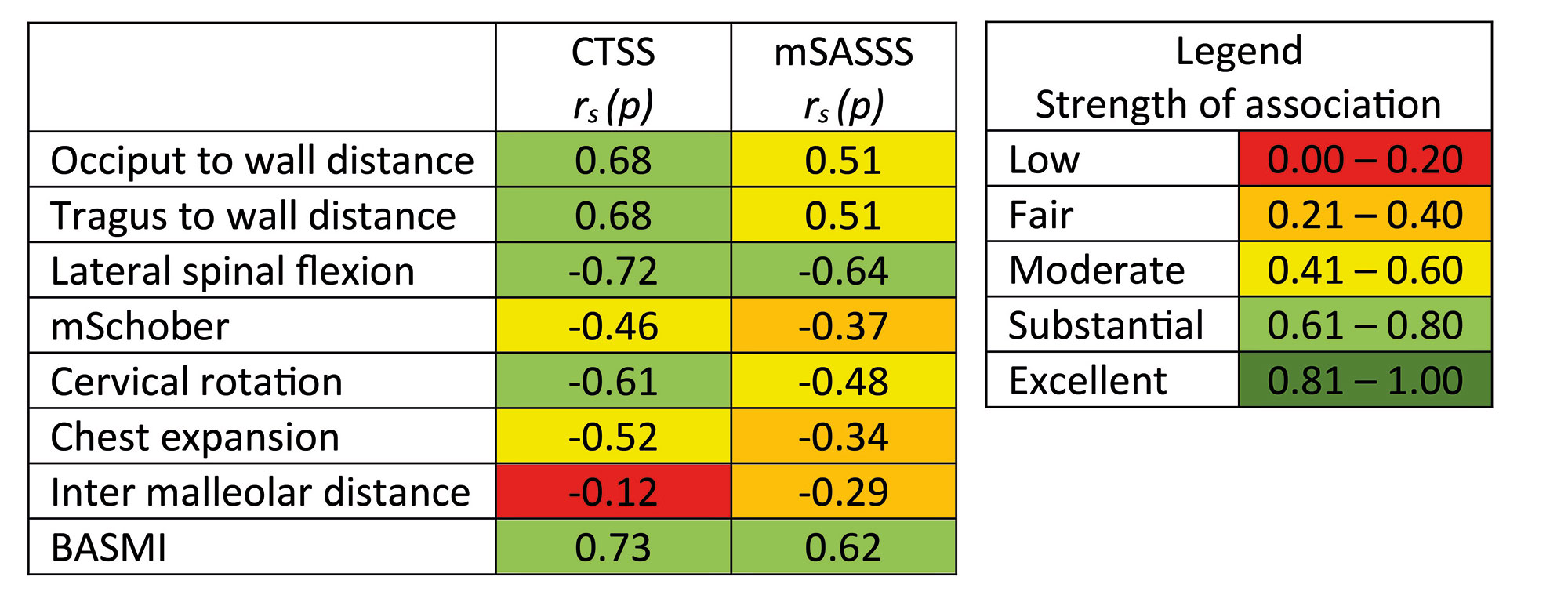Session Information
Date: Saturday, November 12, 2022
Title: Spondyloarthritis Including PsA – Diagnosis, Manifestations, and Outcomes Poster I
Session Type: Poster Session A
Session Time: 1:00PM-3:00PM
Background/Purpose: The modified Stoke Ankylosing Spondylitis Spinal Score (mSASSS) is the best validated and widely used method for assessing radiographic progression in axial spondyloarthritis (axSpA) and is known to correlate with spinal mobility measures. The recently developed Computed Tomography Syndesmophyte Score (CTSS) assesses syndesmophyte presence and size on whole spine low dose CT but correlation with spinal mobility measures has not been investigated.
Methods: AxSpA patients from the SIAS cohort meet the Modified New York criteria and have ≥1 and < 18 syndesmophytes on mSASSS at baseline. Correlations were tested for each of 8 spinal mobility measures (occiput to wall distance (OWD), tragus to wall distance (TWD) (calculated as OWD+11.1), lateral spinal flexion, mSchober, cervical rotation, chest expansion, intermalleolar distance (IMD) and Bath Ankylosing Spondylitis Metrology Index (BASMI)) with CTSS and mSASSS using Spearman’s rank correlation coefficients. A cumulative probability plot shows the relationship between BASMI and CTSS on the patient level.
Results: Forty-one patients (mean age 48 (SD 9), 83% male, 85% HLA-B27+) had scores for both CTSS and mSASSS and all spinal mobility measures. The CTSS showed substantial correlation with OWD/TWD (rs=0.68), lateral spinal flexion (rs=-0.72), cervical rotation (rs=-0.61) and BASMI (rs=0.73)(figure 1). Patient level data is shown for BASMI with CTSS (figure 2). CTSS correlated moderately with the mSchober (rs=-0.46) and chest expansion (rs=-0.52) but not with IMD (rs=-0.12). The mSASSS also had significant correlations with all measures except IMD but all correlations were lower than with CTSS.
Conclusion: The CTSS correlates with 7 out of 8 spinal mobility measures. Lateral spinal flexion and total BASMI correlated best with both methods. The lack of correlation with IMD was expected since hip range of motion is not affected by spinal structural changes. These observed correlations compared favourably to mSASSS and support the construct validity of the CTSS.
Correlations are color coded according to the strength of the association.
The value of the CTSS is shown on the left Y-axis, and the value of the BASMI on the right Y-axis.
To cite this abstract in AMA style:
Stal R, Ramiro S, Baraliakos X, Braun J, Reijnierse M, van den Berg R, van der Heijde D, van Gaalen f. In Radiographic Axial Spondyloarthritis Spinal Mobility Measures Correlate Well with the Whole Spine CT Syndesmophyte Score (CTSS) [abstract]. Arthritis Rheumatol. 2022; 74 (suppl 9). https://acrabstracts.org/abstract/in-radiographic-axial-spondyloarthritis-spinal-mobility-measures-correlate-well-with-the-whole-spine-ct-syndesmophyte-score-ctss/. Accessed .« Back to ACR Convergence 2022
ACR Meeting Abstracts - https://acrabstracts.org/abstract/in-radiographic-axial-spondyloarthritis-spinal-mobility-measures-correlate-well-with-the-whole-spine-ct-syndesmophyte-score-ctss/


